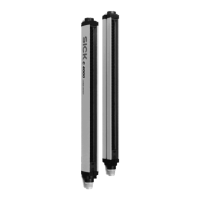Operating Instructions Chapter 10
C4000
Technical specifications
8 009 221/16-11-00 © SICK AG • Safety Systems • Germany • All rights reserved 45
10.2 Response time
The response time depends on the following parameters:
· Number of beams
· Beam coding
· Configuration of floating blanking
· Number of cascaded systems
How to determine the response time of the system:
> Read the response times of the individual systems (shown on type plate). Note whether
the system is operated with or without beam coding.
Note If you are planning the application without actually having any devices available, you may
also determine the response time using the tables 17 and 18. When determining the
number of beams in table 17, the physical resolution is important. The physical resolu-
tion of the light curtain does not change even if fixed or floating blanking has been se-
lected.
> Fill out the following table to determine the total response time.
> Verify that the total response time determined is £ 108 ms. EN 61496 does not permit
response times exceeding 108 ms. If necessary, adjust the configuration.
Example
Calculating the response time for a cascaded system with beam coding in which fields are
configured with floating blanking:
Line Required detail Response time
1Host ms
2Guest1 + ms
3Guest2 + ms
4 Only if
floating blanking
is used:
Longest response time from
lines 1 to 3:
×0,5= + ms
Deduct 4 ms. – ms
5 If exactly 1 guest is used,
then add 8 ms.
+ ms
6 Total response time: Sum of all lines
(The total response time must be £ 108 ms!)
= ms
Line Required detail Response time
1 Host: 750 mm protective field height, resolution
14 mm
16 ms
2 Guest 1: 600 mm protective field height, resolution
20 mm
+ 13 ms
3Guest2: — + 0ms
4 Only if
floating blanking
is used:
Longest response time from
lines 1 to 3: 16 ms
×0.5= + 8ms
Deduct 4 ms.
– 4ms
5 If exactly 1 guest is used,
then add 8 ms.
+ 8ms
6 Total response time: Sum of all lines = 41 ms
Tab. 16: Determining the total
response time of a system

